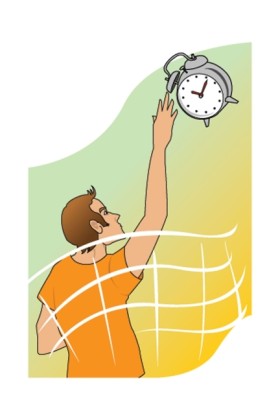
Timing is everything
The timing has to be perfect, and the quarterbacks have to adjust their passes according to each particular receiver. A long pass may stay in the air for two seconds, and a wide receiver that’s running at full speed can cover 20 yards in two seconds. It takes perfect timing to get the ball to that receiver. And if the timing is off by just a little bit, it’ll be overthrown or underthrown, and possibly intercepted. I had the easy part, being a receiver. All I had to do was run my prescribed route; the quarterback bore the responsibility of getting the ball to me.
In volleyball, the responsibility for the timing of a high set lies with the hitter. The timing of an approach, jump, and hit are just as precise as a football pass pattern. The goal, of course, is to contact the ball at the highest point possible. That sounds simple enough, but if you watch young players trying to learn this for the first time, you can get a better sense of how difficult it is to do. And we experienced players often forget just how difficult it really is.
Let’s look at some basic physics. (See kids? Physics class really does matter in your life!) For a typical high set, after the ball has reached its peak, it’s dropping at a rate of 9.8 m/s2 (meters per second squared). A hitter has to time it so that she gets to the net, jumps, and reaches her maximum height on her way up at the same time the ball reaches that exact same height on its way down. It’s really quite a feat if you think it through in scientific terms.
One of the things I’m still struggling with as I make my volleyball “comeback” is my timing. Specifically, the timing of my approach for a plain old vanilla high set. My problem? My hitting approach is still based on what my vertical leap used to be. I haven’t quite adjusted yet.
Or perhaps I’m just in denial and don’t want to adjust.
As young players, we spend years working on the mechanics and timing of our approach until it becomes second nature. And then, our approach remains mostly the same regardless of the type of set we’re hitting. We simply begin our approach earlier or later, relative to the set we’re expecting.
Sure, there will always be times when we have to adjust our approach (or go without one) due to a poor pass, poor set, or when hitting an overpass, but those are the exceptions. I’m having issues with my timing even when all conditions are perfect.
We’ve all experienced this to some extent. In fact, it’s the main reason that every team does a lot of hitting during warm-ups before a match. It’s good to get your blood flowing, your muscles firing, and your timing down.
And if you’ve ever played in a tournament that starts at 9 a.m. on a Saturday morning after a two-hour drive to get there, you know that your first two or three warm-up hits are usually not so stellar. Your legs aren’t quite ready, your vertical is still asleep, and thus your timing is off.
Now think about what it would be like to wake up one day and have your vertical be six inches less than it was the day before, and no amount of warming up will help. If your timing and approach are ingrained from years of contacting the ball at a certain height, say 10 feet, then everything would be completely “off” if you used the same timing but only reached 9’6″.
When this is the case, as you approach the set and jump, the ball will still be out of reach as you hit your maximum height. It results in a “paintbrush” at best (or a “whiff” at worst), and although you can actually get a kill with a paintbrush, it’s the embarrassing type of kill.
Another issue that I had not considered until recently, and that will also affect timing, is the quickness of the leap itself; how quickly you can get to your maximum height once you leave the ground. Think of it as your explosiveness. So, even if I could still jump as high as I used to, if it then takes me a split second longer to reach that height, then my timing will still be off a little.
So, is my vertical maxed out based on my age, and will I have to adjust my expectations and timing accordingly? Or, is it possible to rebuild my vertical to what it used to be? Only time will tell. I’ll continue to work harder than ever in the weight room and gym, and if that doesn’t do it, then I’ll buy a new watch and adjust my timing!